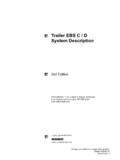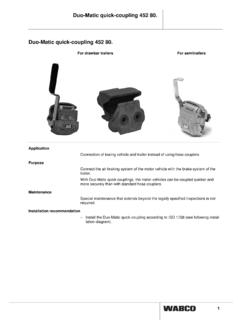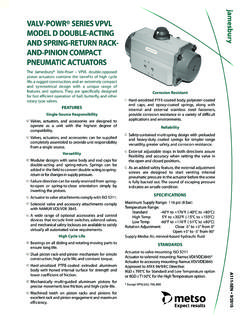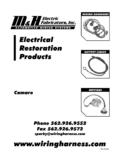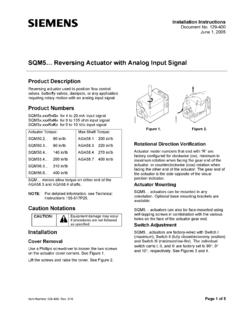Transcription of Levelling valve 464 006 - WABCO
1 Levelling valve 464 006 1 Levelling valve 464 006 Application Vehicles with conventionally controlled air-suspension. Purpose Control of a constant ride height of the chassis by charging the air-suspension while compressing (loading the vehicle) and by venting when releasing. The height measurement is done via the angle of the lever and linkage connected with the axle. Height limitation: The Levelling valves 464 006 100 0, 464 006 101 0 and 464 006 201 0 have an additional 3/2-way valve that closes as of a certain adjust-able lever angle and switches to a venting function upon actuating the lever again. This "Height limitation" prevents the vehicle from being raised above a permitted level with the rotary slide valve . Zero point adjustment: The ride height can be adapted to special application condi-tions of the vehicle with an operating cylinder integrated in the linkage.
2 Maintenance Special maintenance that extends beyond the legally specified inspections is not required. Levelling valve 464 006 2 Installation dimensions 464 006 002 0 Legend 1) Vent 2) Operating range 3) Pressurizing 4) Fixing the valve in end position with 7 bar supply pressure and 3 bar bellows pressure with 3h8 or parallel pin 3h8x 24 DIN 7 Connections Port threads 1 Energy supply (Reservoir) 3 Exhaust 21/22 Energy delivery (Air suspension bellows) M - 12 deep Levelling valve 464 006 3 Installation dimensions 464 006 100 0 View X Connections Port threads 1 Energy supply (Reservoir) 3 Exhaust 12 Energy supply (Supply) 1, 21, 22 M - 12 deep 21/22 Energy delivery (Air suspension bellows) 23 Energy delivery (Rotary slide valve ) 12, 23 M Levelling valve 464 006 4 Levelling valve 464 006 .. 0 Linkage 433 401 003 0 The linkage 433 401 003 0 must be ordered separately.
3 Legend Deflection of the Levelling valve lever max. 45 . AA is the dimension between axle mount-ing point and the connection to the level-ling valve lever ( -character). L Lever length (at least 150 mm) For adjusting the valve at the vehicle it is decisive which total spring travel the axle permits. Approximate value: The ratio "lever length L / rod length A" should be if the closing angle of maximum 45 is not exceeded. The lever length L should be 150 to 295 mm. If a shorter lever has to be used, a higher air consumption of the Levelling valve has to be concerned. Installation recommendation and setting information Fasten the Levelling valve vertically or horizontally with two M8 bolts on the chassis. The drain must point downwards. To make installation and setting of the lever and linkage easier, you can insert a 3h8 locator pin or a 3h8 x 24 DIN 7 parallel pin into neutral position to posi-tion the air-suspension valve shaft (see previous installation dimensions).
4 Install the linkage if the vehicle is positioned at normal level. The linkage has to be aligned vertically. Mount the Levelling valve at maximum lever length if possible. You can clamp the lever at the desired length with the hexagon head bolt seated on the fastener for the round bar. Depending on the fitting position various cranks of the lever are possible. Levelling valve 464 006 5 By accordingly fixing or turning the lever for 180 the Levelling valve can be op-tionally operated from right or left. Depending on the final installation position - vertical or horizontal - the lever is to be inserted through one of the two bores in the operating shaft which are offset by 90 to one another. The Levelling valve 464 006 100 0 is set to a closing able of 30 2 in the fac-tory. The setting adjustments lie between 15 and 45.
5 A closing angle of < 15 is not permitted. Note the adjustment data of the vehicle manufacturer when replacing. For adjustment of the closing angle the rubber plug underneath the 3/2-Directional Control valve has to be removed to adjust the adjusting screw with a Torx T30 screwdriver: Counterclockwise means a reduction of the closing angle, clockwise means an increase. One rotation means an approx. 13 angle change. The following table can be used to define the height increase of the vehicle up to shutting the supply air off to the rotary slide valve as a function of the closing angle and for determining the lever length. After the vehicle has been lowered to its buffers with the help of a rotary slide valve , measure the height of the chassis. Then raise the chassis with the rotary slide valve . If the permissible full suspension travel is achieved before the height limita-tion of the Levelling valve is applied, cancel the raising process and lower the vehicle.
6 Turning the set screw counterclockwise reduces the closing angle and also the suspension travel. If the height limitation sets in before the chassis is at the required hub height, the vehicle has to be lowered slightly as well in this case. Turning the self-locking set screw clockwise increases the closing angle and the suspension travel. Repeat the process until the required suspension travel (equal or less than the maximum suspension travel specified by the axle manufacturer) is achieved. Adjustment values Hub height H [mm] Lever length L [mm] = 15 = 20 = 25 = 30 = 35 = 45 125 32 43 53 62 72 88 150 39 51 63 75 86 106 175 45 60 74 87 100 124 200 52 68 84 100 115 141 225 58 77 95 112 129 159 250 65 85 106 125 143 177 275 71 94 116 137 158 194 295 76 101 125 147 169 209 Levelling valve 464 006 6 Lever length L [mm] Hub height H [mm]
7 = 15 = 20 = 25 = 30 = 35 = 45 50 193 146 118 100 87 71 60 232 176 142 120 105 85 70 271 205 166 140 122 99 80 309 234 189 160 140 113 90 263 213 180 157 127 100 293 237 200 174 141 110 260 220 192 156 120 284 240 209 170 130 308 260 227 184 140 280 244 198 150 300 262 212 160 279 226 170 297 241 180 255 190 269 200 283 Technical data Order number 464 006 002 0 464 006 100 0 464 006 101 0 464 006 102 0 464 006 201 0 3/2 directional control valve No Yes Yes No Yes Max. operating pressure 13 bar Max. dynamic bellows pressure 15 bar Permissible medium Air Operating temperature range -40 C to +80 C Linkage Round bar 6 mm Nominal width Levelling valve 2x 3 mm Nominal width Shut-off valve 6 mm Weight kg kg kg kg kg Quickfit connections 5x 8x1 5x 8x1 For the zero point adjustment on the Levelling valve , the following operating cylin-ders can be used: 421 410 023 0, Hub 25 mm 421 410 054 0, Hub 45 mm 421 411 304 0, Hub 85 mm; with piston rod facing upward, use bellows (Accesso-ries pack 421 411 530 2) Levelling valve 464 006 7 Operation With increasing load, the chassis moves down with the Levelling valve fastened to it.
8 The connection between the vehicle axle and the Levelling valve presses upon the lever (f) and the guide (d) upward via the cam (e) during the process. The tappet seated on the guide opens the inlet valve (b) at the same time. The compressed air fed into the device from the supply reservoir via connection 1 and the check valve (a) can now flow into the Levelling bellows via connections 21 and 22. To reduce air consumption to a minimum, grooved windings on the tappet change the cross-section of the air openings in 2 stages according to the size of the lever deflection. The end position of the valve is achieved by means of raising the trailer box result-ing from filling the bellows and closing the inlet valve (b) controlled by lever (f). In this position, connections 21 and 22 are connected with one another through a cross flow throttle. The process is reversed upon relieving the load on the vehicle.
9 The vehicle con-struction is now raised by the suspension bellows that are applied with too much pressure and the lever (f) with the cam (e) and the guide (d) pulled down. This low-ers the tappet from its sealed seal on the inlet valve (b) so that the excess air can flow to atmosphere from the suspension bellows via the vent hole (c) of the tappet and the vent openings 3. The resulting lowering of the box moves the lever (f) back to its normal horizontal position. Closing the vent hole (c) by setting the tappet on the inlet valve (b) puts the Levelling valve back into its end position.
